|
|
| Notes from the Summer |
I had the pre-party jitters, prompted by my wife Claude's annual neighborhood fête, which is held in July. Not that I would play any role in the proceedings, beyond popping a few corks. Claude's cousin Jeanne would be helping and she's an expert caterer, and Claude herself is a marvelous cook--that end was fully covered, I knew.
I was worried about the social aspects of the party. Despite its motto--liberty, equality, brotherhood--France retains some of its old class consciousness. Maybe not like England, where in certain precincts--Oxbridge, to put a finer point on it--the "wrong" accent will get you a sniffy look. Yet in France it's still there.
And what an eclectic mix the party would be!
The baker, the butcher, the candlestick maker were just for starters. There would also be the hairdresser, surgeon, crane operator, factory manager, art dealer, charcutier, ironmonger, librarian, beautician, farmer, anaesthetist, and on and on.
This was not an American-style cocktail party where everyone bumps up for thirty seconds and starts looking over shoulders for the next brief encounter. Nor would it be a tray-gathering around the electronic fire when quick comments about the whiz of programs (if a man holds the zapper) pass for conversation.
No, these people would be sitting down to dinner together. Actually talking to each other. Eye to eye. How remarkable that seemed to an American, even after so many years in France.
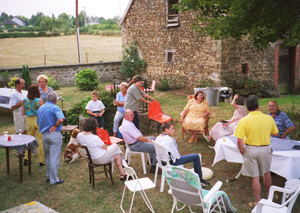 |
| Guests begin to arrive for the neighborhood party.
At any gathering of the French, one subject is inevitably the main topic of conversation. |
Yes, I admit it, that was my twitch: What in the world would this diverse group find to talk about?
The French consider it impolite to ask the kind of personal questions that an American will ask another American in an instant.
"Where'd you go to school? Whattaya do?"
So a major conversational area was out, as was talking about politics or religion. Perhaps surprisingly, considering their reputation, they were not likely to speak about sex, either. And Frenchmen usually respect women enough not to bore them with sports talk at the table.
Well, as I really knew deep down, I had nothing to worry about. The French, whatever their background and profession, can make conversation in a social situation probably easier than any other nationality.
The reason is simple. To get up close and personal, they talk about food. And wine. Topics which remain the national passion. Everybody has a story about their favorite meal, their favorite dish. And everybody else listens, awaiting their turn to describe a long-ago trip to an out-of-this-world restaurant.
Since the party falls in the month of both our national days, we usually bring out the French and American flags. (The French, by the way, never call it "Bastille Day," it's always Quatorze Juillet, July 14th.) And Claude tries to split the menu between French and American dishes.
This time she prepared a twenty-pound ham, Virginia style, and made potato salad, based on a recipe given years ago by my mother. That may sound rather boring to an American, but to the French it was exotic.
Which started our French guests to talking about their favorite subject. Only this time the topic was not French food but American. And what they had to say made me squirm.
There is a revolt in America against genetic modification and the use of hormones and additives. But compared to France, it looks like no more than a small guerrilla action. The French want nobody messing with their food.
They've been at war with Britain for nearly a decade over the "mad cow disease," still refusing to import British beef even after it has been cleared by the European Union.
And many of them--I'd say, most--don't want their country to import American meat or vegetables that have been fiddled with. Now this isn't one of the routine cycles of anti-Americanism that periodically roils France and passes like a summer storm. There is an underlying feeling that the U.S. has grown too economically and politically powerful. But the question about the direction American food is taking is very serious stuff, independent from the rest.
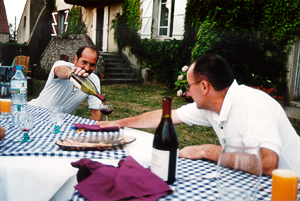 |
| The Ceremony of the Last Drop. The party became a roaring success after I admitted that I didn't like the genetic altering of food, either. |
To make it worse, McDonald's has become the symbol of the revolt for many of the French--and someone very close to me rents a property in Paris to the very enemy in question. Quelle horreur! As you can imagine, I was not anxious to disclose this bit of intelligence to our guests, which would have placed me and my "someone" in the ranks of the collaborationists.
As it was, when I mentioned that my garden contained American corn, somebody suggested, as politely as possible under the circumstances, that I was a butterfly killer. Moi? The charge stung enough that I began to monitor the butterfly population in and around the garden, and was relieved to record no diminution in numbers from past seasons.
I always defend the flag as a matter of principle by launching a counterattack against some French felony committed a few centuries ago. The Burgundians helped the English burn Joan of Arc, didn't they?
But I must admit that I was hard put to counter the French stand against genetic modification. I threw out the standard American argument: "There have been no long-term studies that indicate a negative effect from the genetic altering of fruits and vegetables, or the use of hormones and steroids in meats."
And I got what I deserved in return: "What studies? What does long-term mean?"
Actually, my heart was not in it. The question of genetic altering makes me uncomfortable, and I wish America would not plunge headlong into this technology just because it exists. If this be treason, make the most of it. Once I admitted that I agreed with them, the party got back on track and was a roaring success.
Everybody praised the American-style ham and potato salad to the high heavens. You would have thought they'd never eaten anything so delicious.
Of course, we all knew where it came from.
Duquesa Turns 100
Summer was also a time to celebrate our animal companions. Is that politically correct -- animal companions? Duquesa had her sixteenth birthday which, in human terms, made her a 100 years old.
Duquesa is a pure-blooded Spanish goat dog (and the longest lived on record), but she has spent most of her life in Paris, where she was considered something of a phenomenon. Duquesa was one of the few curb-trained dogs in the city.
|
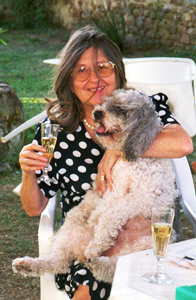
Claude toasts Duquesa on her 16th birthday with Champagne.
Duquesa loves lamb chops and foie gras, yet has lived to be 100 years old in human terms.
The French canine paradox? |
In fact, it seemed like she was the only one, not counting my American friend Deborah's dogs. Patrons of the famous La Coupole on the Boulevard Montparnasse would gape as Duquesa, unleashed, hopped off the curb to do her business, ignoring the buses that passed three inches away.
"How did you do that?" I was often asked by astonished French dog owners.
I tried to resist making a sardonic reply ("Simple, I trained her"), for I knew that, to Parisians, the idea of training a dog was as esoteric as nuclear physics. The city has one dog for every four inhabitants, probably a higher dog ratio than any city in the world. It also has a good system of easy to clean gutters.
Yet walking Parisian sidewalks is much like walking a dog-doo obstacle course. Dog owners constitute such a powerful electoral force that no city government has been able to do anything about it.
The Cartesian answer to the problem, proposed by the government, was to outfit a battalion of motorcycles with a vacuum device to clean the sidewalks and to leave a spray of deodorant. To my puzzlement, the motorcycle drivers always appear quite happy with their work, as they scoot around scooping. It's as though they believe they are performing a service in the national interest--and I suppose they are.
In any case, Duquesa has always acted like a true duchess. Now she wobbles around, blind, nearly deaf and toothless, but still acutely attuned to the delights of eating. Her vet, a woman in her thirties, believes in homeopathic medicine for animals. She has prescribed ginkgo biloba--and whether it works for humans or not, I don't know, but it sure does for Duquesa.
For companionship, we introduced Dolly Belle, a tri-colored Shetland collie, but this turned out to be a case of the halt leading the blind. Ironically, Dolly's breeder was so enthralled by the finer points of a potential show dog that she didn't notice the broken front left leg, which apparently occurred during sibling play in the second month. An operation conducted after she came to us was only partially successful.
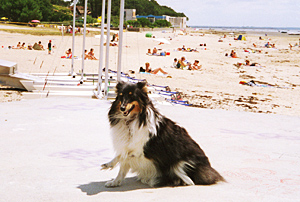 |
| Dolly Belle, our Shetland with a broken leg--cat's best friend.
She creates a stir among the French wherever she hippity-hops. |
But Dolly Belle walks with a distinctive hippity-hop which, to my amazement, has also turned her into something of a phenomenon--a celebrity, really. When we were vacationing at a beach resort near Bordeaux, I was constantly stopped--sometimes followed by cars--by people who wanted to hear the story of Dolly's plight.
Thinking about it, I could not recall ever seeing another handicapped dog prancing about so cheerfully in France.
Somehow, they don't seem to make it into society.
Dolly's problem is not her broken leg but our two cats, Misa and Millie. Sensing her handicap, they have decided she would better face the world as one of them, and they have embarked on a program of species bending, trying to turn her into a cat. If the number of live mice that Dolly has brought to the door is any indication, they haven't been entirely unsuccessful.
But she's undergoing counseling ("Dammit, Dolly, no more mice!"), and I'm pleased to report progress.
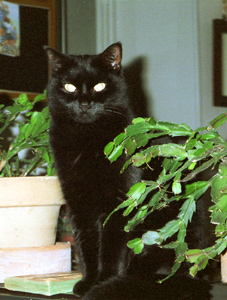
Misa, the chief co-conspirator who is trying to teach Dolly Belle to be a cat. Under her tutelage, Dolly has learned to be a mouser. |
|
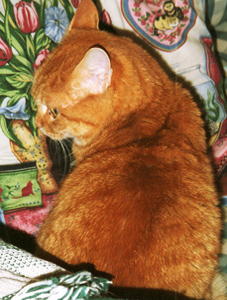
Claude smuggled Millie from the Greek island of Milos when she was an abandoned, starving kitten near death. We had a theory that abused kittens grow up to be humble, affectionate cats. As she recovered her health, Millie imperiously demanded to be treated like a queen. So much for cat theory. |
A Summer with Max
"My friend Max claims to be able to do 50 interesting things," I often tell people. "But he exaggerates. He can only do 25."
That, of course, is about 20 more than the rest of us guys. Here are a few things that Max can do:
He's a good truck, car, and tractor mechanic; an excellent baker and patisserie maker; a passable electrician and plumber who can install air conditioning; an expert hunter and fisherman who always eats what he kills or catches; an impressive farmer whose bountiful garden augments ours; a restaurant-level cook.
Add carpenter to that. This summer Max made us a new barn door--made it and mounted it entirely by himself, an accomplishment that can only be appreciated by seeing how huge and heavy it is. Then he hauled us seven cubic meters of oak firewood, and cut and split it himself.
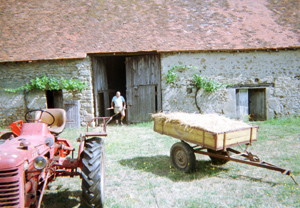 |
|
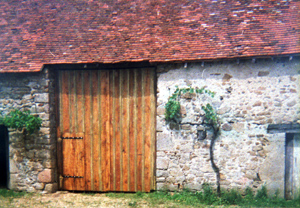 |
| Max replaced our 125-year-old barn door with a new one, which he says will look very good in 30 to 50 years. |
|
Max made and mounted the barn door entirely by himself. Since we had the wood, and he scavenged most of the other things he needed, it cost us about $100, mainly for the varnish and anti-insect treatment. |
For a finale, he climbed the tall wild cherry tree at his farm, spent two hours picking the deliciously perfumed cherries, then made us a clafoutis, the likes of which cannot be found in any restaurant.
And all this with a gimp knee. Yep, I tell you, Max is something.
Saving Saint-Sauvier
Meanwhile, Claude spent a busy summer working with a group which is restoring the chapel at Saint-Sauvier, where her grandfather was born. The chapel, which measures about 18 meters by 9 meters, was built in 1669 by Cistercian monks and dedicated to Saint Jean the Baptist.
A member of Henry IV's court had a stomach ache and stopped to drink from the steam that runs by the chapel wall. The stomach ache suddenly disappeared, and news of the miracle spread far and wide.
From then on, the chapel became a destination for a pilgrimage which took place on the Sunday following June 24, Jean the Baptist's Catholic saint day. The pilgrims had to be forbidden, however, in 1827, from diving into the chapel's icy stream. They were seeking miraculous healing but often dying from pneumonia.
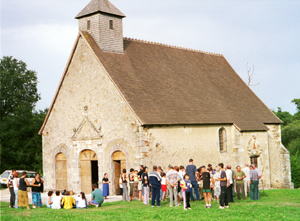 |
| The chapel at Saint-Sauvier. A party was held to celebrate the 11 international students who came to help with the restoration. |
After the separation of church and state in 1905, the chapel at Saint-Sauvier experienced hard times. The village was too small to provide the funds necessary for its upkeep. Since then, it has fallen to people like Claude and her friends to preserve this historical monument.
This past summer an international organization sent eleven college students--two Belgians, two Spanish, a German, four French, a Korean and a Czech--to work on the restoration. The village provided them with camping equipment, food, and bikes.
Claude served as a translator for the two Spanish girls, and took them on excursions around the countryside. I'll write in more detail about "Saving Saint-Sauvier" in a future Village Letter.
Summer's End
I knew the summer was over when Ariane, 20, stopped to say goodbye before heading to the first year of law school in Paris. We made a deal. She'll keep a journal, and I'll describe her adventures in future Letters, as she goes through school.
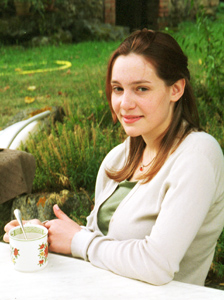 |
| Ariane before leaving for the university. She already has an apartment in Paris and an Italian boyfriend. Not bad for a first-year law student. |
|
| Recipe Four
Madame Binon's Sanguette (Sanglette)
Summer was a time to prepare a few of our free-range chickens for the dinner parties that take place in the dreary months of winter.
I always say that everybody should be prepared to kill what they eat. And then I usually run on about how modern society has become squeamishly detached from the realities of its own dining habits.
What I really mean, though, is that everybody should eat what Madame Binon is prepared to kill. Madame Binon, who arrives on her motorbike to help us, is probably the last generation of real paysannes, country women inured to hardship of any kind who are experts at cultivating and raising practically everything they eat.
One law of the countryside has always been that a chicken is to be eaten completely except for "les plumes et la merde." And from this comes the recipe for a sort of blood crêpe or pancake called "sanguette," sometimes "sanglette." "Sang" is the French word for blood.
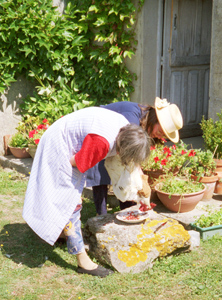 |
| Madame Binon and Claude (hat) bleeding a live rooster into a plate of sliced onion to make a sanguette, a delicacy in the French countryside. Claude is faking it. She refuses to kill anything--but she'll cook it. |
Once popular throughout France, sanguette is no longer found in restaurants, except occasionally in bistros in the deep countryside. Fresh blood of the chicken or turkey must be used, and it must be cooked as soon as it coagulates. Few restaurants these days do their own butchering.
Neither Claude nor I eat sanguette, but some of our friends and neighbors do, so we try to honor the tradition of the country when we--I mean, Madame Binon--prepare the chicken for freezing.
The last time we did it I took part in the chase, trying to help Madame Binon catch a rooster that knew what was up and was being distinctively uncooperative. I retired after I split my jeans when I made a grab for him. ("You lost face in front of Madame Binon," Claude said in English. "No," I replied, "I lost fesses."--a corny pun; almost pronounced like face, fesses means butt in French.)
Once Madame Binon caught the rooster, I asked if I could do anything to help. "Yes, give me a sharp knife," she said.
The ingredients for a sanguette are simple. Garlic and parsley. Onions or shallots. The Larousse Gastronomique gives the most common recipe. First, it emphasizes, you must have the fresh blood of poultry raised at home.
You don't want the blood of some hormone-filled, penned-up, unhealthy chicken. I hope you can find this where you live, but if you can't, come to see us. Then, translating directly, you...
"Let the blood drip onto an earthenware plate, which has a bed of parsley and finely chopped garlic, often with the addition of little pieces of lean bacon. When the blood is coagulated, turn the plate over into a frying pan, add a little pork or goose fat, and cook it on both sides for a short time as you would a crêpe [or pancake]. Then transfer to a round plate and sprinkle a little vinegar on top."
Well, we were making this sanguette for Max, who loves it, as thanks for the new barn door, and Max, being Max, has his own special recipe, which Madame Binon was amenable to following. In fact, Americans may find it more appealing than the Larousse version. Here is Max's:
"Finely chop a medium-sized white onion into a recessed plate. Add pepper and salt to taste. Sprinkle a dozen thumb-nail size pieces of butter throughout. Hold a live chicken over the plate, slit the throat, and let the blood drop into the plate to cover the onion. Turn the plate over into skillet. Using a medium heat, cook on both sides, like a pancake; it should be no thicker than a finger. Stick a fork in it and if no blood shows, it is done."
Oh yes, I forgot. The blood. Madame Binon pinches the neck artery with two fingers and pierces it with the tip of the knife, to make the hole as small as possible as it pumps out the blood with every declining heartbeat. She does it this way, very neatly, in case you want to eat the head.
How does it taste? Yes, I've eaten it. Like a blood and onion pancake. Very crunchy. As the French say, "Chacun son goût."
|
|
Next Letter: My Last Hunt
Previous Letter: The Real Deal--Movies or Cheese? |
| |
|
|
| ©Copyright 2010, 2009, 2008, Pythia Press. All rights reserved. |
|